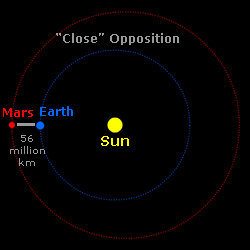Jupiter and its four largest moons.
Click on image for full size
Image courtesy NASA
More and more Moons of Jupiter
News story originally written on March 20, 2003
Astronomers have discovered a dozen new moons of Jupiter
so far in 2003. Scott Sheppard and David Jewitt of the University of Hawaii
and Jan Kleyna of Cambridge University led the team of astronomers who discovered
the new moons. Jupiter now has a total of 52 known moons. All of the new moons
are very small, ranging between one and four kilometers in diameter. They all
orbit Jupiter in the direction opposite Jupiter's rotation; such orbits are
called retrograde.
The moons were discovered using telescopes on the top of the volcano Mauna
Kea in Hawaii. For now, the moons all have temporary names. They are called
S/2003 J1 through S/2003 J12 ("S" for satellite; "2003"
for the year they were discovered; "J" means they are moons of Jupiter;
and the 1 through 12 at the end indicates the order each was discovered). Later
the moons will be given "real" names. Astronomers think there may
be as many as 100 moons with a diameter of one kilometer or greater orbiting
Jupiter! Jupiter, the largest planet in our Solar System, has more known moons
than any other planet.
You might also be interested in:

Astronomers have recently discovered several more moons in our Solar System. Scott Sheppard and David Jewitt of the University of Hawaii and Jan Kleyna of Cambridge University announced the discovery of
...more
Astronomers have discovered a dozen new moons of Jupiter so far in 2003. Scott Sheppard and David Jewitt of the University of Hawaii and Jan Kleyna of Cambridge University led the team of astronomers who
...more
On August 27, 2003, Earth and Mars will be closer together than they have been in thousands of years. The centers of the two planets will be 55,758,006 kilometers (34,646,418 miles) apart at 9:51 Universal
...more
The planet Mercury appeared to cross in front of the disk of the Sun on May 7, 2003. Astronomers call the event a transit. A transit is similar to a solar eclipse. However, a transit occurs when a planet,
...more
Two gigantic sunspot groups have recently appeared on the Sun and are generating tremendous space weather storms. The sunspot groups (known as group 484 and group 486) are about as large as the planet
...more
Astronomers have identified another exoplanet, that is, a planet outside our solar system. This makes a total of 102 exoplanets that have so far been found by astronomers! The astronomers that identified
...more
Thanks to a couple of telescopes, everyone on the internet can browse through almost 2 million images. Stars throughout the sky were photographed by the Two-Micron All Sky Survey (2MASS) and are now available
...more
Earth may look perfectly spherical from space, like a giant marble, but it actually isn't! Since the first satellites were launched, scientists realized that Earth is not a sphere. Instead, our planet
...more














